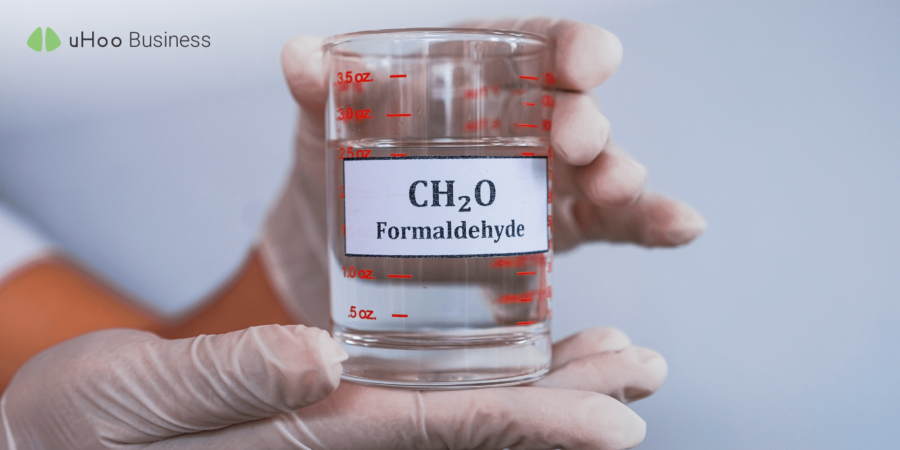You might have come across formaldehyde in some of our blog posts, as it is among the most prevalent air pollutants that individuals and organizations must be aware of. Curious to delve deeper into this intriguing compound? We’ve compiled a collection of interesting formaldehyde facts!
Discover more about this ubiquitous yet often overlooked chemical and how the exposure to formaldehyde can impact our health and the environment.
- Formaldehyde is a substance made of carbon, hydrogen, and oxygen.
- Formaldehyde is classified as a VOC, a category of chemicals that can evaporate into the air and potentially affect indoor air quality.
- At room temperature, formaldehyde is a colorless gas with a strong, irritating odor. It is highly soluble in water and forms a colorless, flammable solution.
- Formaldehyde becomes formalin when it is dissolved in water. Formalin is a solution of formaldehyde gas in water, and it is typically used in various applications, including as a preservative, disinfectant, and as an embalming fluid.
- Formaldehyde is naturally produced by every living being – In fact, humans produce about 1.5 ounces of formaldehyde every day as part of our normal metabolic process.
- Some fruits that have relatively significant amounts of formaldehyde are bananas, pears, grapes, and apples.
- Formaldehyde can also be found in vegetables, such as carrots, spinach, and cucumber.
- It can be present in man-made materials such as glues and adhesives, paints air fresheners, tobacco, and cleaning products
- The optimum range of exposure to formaldehyde should be below 40 ppb or below 50 μg/m³.
- Formaldehyde is one of the most-studied chemicals. Scientists have been thoroughly examining formaldehyde for more than 40 years. Within these years, studies have brought us information on how to safely handle formaldehyde, as well as how formaldehyde can impact your health.
- Short-term exposure to formaldehyde can cause eye, nose and throat irritation. At higher levels, formaldehyde exposure can cause skin rashes, shortness of breath, wheezing, disruptions in lung function, and cancer.
- Children, elderly, pregnant women and people with breathing problems are most at risk of formaldehyde-related problems.
- Construction, plastic manufacturing companies, foam manufacturers, and funeral companies are businesses that are commonly exposed to formaldehyde.
- High levels of formaldehyde are also often found in newly constructed indoor environments. Carpeting, paints, and treated wood used in the construction contain formaldehyde that will eventually off-gas of evaporate into the air.
- Formaldehyde can contribute to the formation of ground-level ozone and smog when released into the atmosphere.
- Discharge of formaldehyde into surface waters, either through industrial effluents or runoff from contaminated areas, can contaminate rivers, lakes, and streams.
- Formaldehyde can be toxic to aquatic life, affecting fish, amphibians, and other organisms. It can disrupt aquatic ecosystems and harm biodiversity.
Formaldehyde management tips
- Identify all potential sources of formaldehyde including products, materials, and processes.
- Measure formaldehyde levels using an air quality monitoring device equipped with a formaldehyde sensor.
- Replace or substitute formaldehyde-containing products and materials with less hazardous alternatives when possible.
- Enclose and isolate processes that generate formaldehyde to prevent its release into the air.
- Install local exhaust ventilation systems with proper hoods and filters to capture and remove formaldehyde emissions.
- Maintain and regularly inspect ventilation systems to ensure they are functioning correctly.
- Develop workplace policies and procedures that comply with applicable regulations, such as those set by OSHA (Occupational Safety and Health Administration).
- Create a formaldehyde exposure control plan that outlines responsibilities, procedures, and safety measures for handling formaldehyde.
- Conduct employee training programs on the safe use and handling of formaldehyde-containing materials, as well as the importance of personal protective equipment (PPE).
- Encourage good hygiene practices, such as regular handwashing, to minimize the risk of formaldehyde contamination.
Remember that formaldehyde exposure control measures should be tailored to your specific workplace and industry.
By gaining knowledge about formaldehyde and its associated risks, you’ll be better equipped to implement effective control measures, protect the health and safety of employees, and ensure compliance with relevant regulations. Additionally, ongoing education and awareness can help create a safety culture that prioritizes formaldehyde exposure control and a better work environment.


